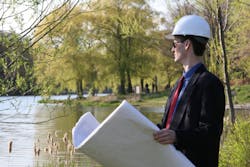Three experts appointed to assess planned sewage dump into St. Lawrence River
OTTAWA, Ontario — Oct. 18, 2015 — The Canadian government has appointed three scientists to study the City of Montreal‘s plan to discharge eight billion liters of untreated wastewater into the St. Lawrence River, according to a press release.
Officials claim there is no viable alternative to the controversial plan, which involves a major sewer interceptor being diverted into the river during demolition of the Bonaventure Expressway, noted the release. This would send about one-third of the city’s raw sewage from storm drains, homes and industry directly into the river over the course of a week.
Last week Canada’s Environment Minister Leona Aglukkaq issued a temporary order to stop the planned release.
After looking into the matter, Environment Canada determined that the environmental impacts of the discharge are likely to be significant, stated the release. But the agency said it could not conclude whether or not the untreated wastewater would be acutely toxic.
Aglukkaq ordered an independent expert scientific review of all information related to the project.
The expert panel will consist of: Robert Hausler, PhD, Professor in the Department of Construction Engineering at École de technologie supérieure (ETS); Viviane Yargeau, PhD, Associate Professor & P. Eng., Department of Chemical Engineering at McGill University; and Daniel G. Cyr, PhD, Professor at INRS-Institut Armand-Frappier (Université du Québec).
The three scientists will consider matters such as the environmental risks of both planned and unplanned releases, and whether the City of Montreal could take other technically feasible measures to mitigate the effects of the planned release.
They will also examine whether there are other parameters that should be included in the City’s planned water quality monitoring that would increase its effectiveness, reported the release.
Federal restrictions on the City of Montreal’s project will be in effect until the end of November 2, 2015, pending the results of the independent review.
Commenting on the appointment of the panel, Aglukkaq said in the release, “The St. Lawrence River is one of Canada’s most important waterways, acting as a home to several species of whales and fish while providing millions of Canadians their drinking water. The Government of Canada is concerned with the City of Montreal’s plans to discharge eight billion liters of raw sewage in the St. Lawrence River. This is why I’ve mandated today a panel of three independent experts to assess environmental impacts that could result from this discharge.
“These experts, who are renowned in their fields, will be supported by and supplement the scientific expertise of Environment Canada. This will ensure we have the best possible and most complete scientific analysis for this project, and therefore the best possible protection for the St. Lawrence,” Aglukkaq added in the release.
